#blackstone painters
Explore tagged Tumblr posts
Photo

Modern Bedroom Nashville Example of a mid-sized minimalist master bedroom design
#tray ceiling white trim#franklin#bedroom#teal walls#tennessee painters#master bedroom#blackstone painters
0 notes
Text
Master - Modern Bedroom

Mid-sized minimalist master bedroom design illustration
#teal walls#tennessee painters#white tray ceiling#blackstone painters#tray ceiling#franklin#master bedroom
0 notes
Note
Can we hear some vague plans about the court painter au hihi 👀 if you don't mind ofc
ofc!
So for anyone unfamiliar court painter Rachel it basically just started as Prince!Alabaster x Guard!Ethan x Court Painter!Rachel and it kinda just spiralled from there.
The main plot is basically just schemers scheming with a side plot of every single character, bar maybe 2, is abusing or has abused their power in some way /hj.
Our main background is that Rachel’s parents are both members of Hecate’s court. When she was a kid she lived in [whatever the name of Hecate's kingdom is, I'm bad at naming places] and was friends with Al, but her parents sent her to Hades' kingdom, the neighbouring kingdom, for what was basically a finishing school (ik that's not technically the right term for whatever period of time this au is inspired by but it's close enough). However, they didn't account for the fact that she was in another kingdom, away from them. So girl fucked off to do art for Hades kingdom. When Alabaster found out he immediately sent for her to move back, under the guise that he was just an interested sponsor of the arts, because he, like his mother, is very bad at handling change! This will cause problems! So Rachel's having to deal with the fact that she disobeyed her parents and they can't do anything but silently hound her for it because they have a lot more to gain if they keep being nice to her (more on that later)
Moving over to Alabaster and what's been going on in Hecate's kingdom, things have been going well (assume this is the last time you will see this phrase). Al and Lou have been doing well, with Al preparing to take over from Hecate when the time comes and Lou exchanging very flirtatious letters with the princess of Hades' kingdom, Hazel! Alabaster has been trying (and failing) to not flirt with his new guard, Ethan. Hecate being... Hecate has given Al more power than he should probably have for his age, but surely nothing bad will ever come of that!
Ethan's been doing a lot, he's been trying to live up to his mother's image because she's very feared respected by people. His father does... something. Becoming a royal guard wasn't his original goal but Nemesis pushed him towards it.
That's our general character background, there's more characters but these 3 are the focus, moving away from the bg, I should probably get into the main plot (keeping under the cut both because spoilers and also this is long already
OH BABY THE PLOT!!!
As I said before, it's basically just schemers scheming.
Mr. Dare has realised that if he sets up Rachel and Alabaster, he gets to have a lot more power than he ever would as a courtier. The problem being: Rachel kinda hates him, so he just has to grit his teeth and try and be nice to Rachel just so he can invest in his own future. Rachel is aware of this and is very much not a fan.
Nemesis is very similar to Mr. Dare, in that she's trying to get more power through her kid, the difference being Nemesis has someone working with her. Enter Morpheus, everyone's least favourite chancellor (/aff). Morpheus is a lot of things in this au but he is mostly the worst. I love him, but he's the worst. He and Nemesis are working together, mostly. They disagree on a few things (murder) but they'll probably be fine.
As I've put in this drabble, Ethan and Rachel do not like that their parents are plotting, so that's mostly how they bond, over their anxieties of the future. Alabaster isn't completely oblivious, for all his pining and trying to make his life a romance book, he's not foolish. He has grown up around courtiers trying to take advantage of him, he can tell when people are plotting. It's a trait he and his mother both share in this au. But he also knows Ethan, and Ethan loves both of his parents more than anything and probably won't want to feel like he needs to choose between his mother and his partners. So he doesn't got to Ethan, he goes to Rachel.
There's other smaller plotlines that I still need to work the kinks of (a personal favourite of mine is one that starts with "oh sweet, I think I've made a friend here" and ends with "aita for accidentally causing a breakup" while it does have a place in the greater plot, it sounds so funny in my head when it pitch it like that) but generally I am just trying to see where the characters pry their way to.
This didn't have as many vague spoilers as I wanted hang on Father issues suck don't they? Ethan can't relate to that, he loves his father. Damn I wonder what would happen if he ever were to meet our two other main characters. Surely it won't throw a wrench in any plans.
#take a shot everytime i say scheme#pjo#percy jackon and the olympians#court painter rachel#artemx aus#there i used the tag are you proud of me#ethan nakamura#alabaster torrington#rachel elizabeth dare#rachethabaster#lou ellen blackstone#louzel#this turned out so much longer than it was meant to#whoopsies
10 notes
·
View notes
Text

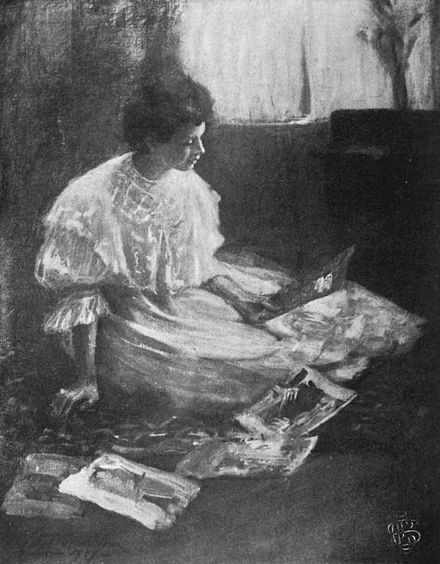
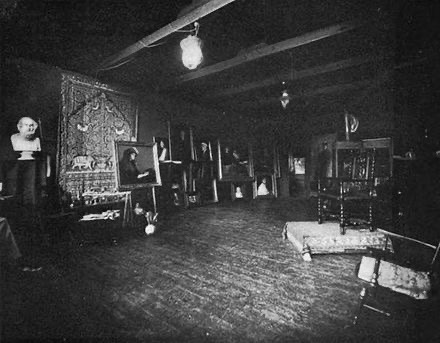
Harriet Blackstone (November 13, 1864 – March 16, 1939) was an American figure and portrait painter. Many of her subjects were midwestern business leaders and their families she also painted a number of prominent musicians. All via Wikipedia
2 notes
·
View notes
Text
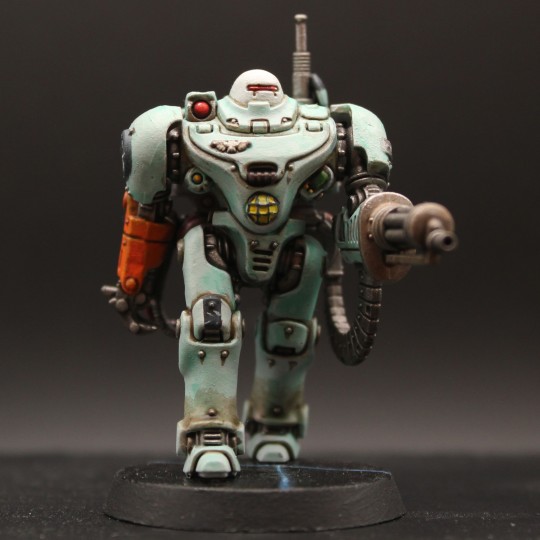
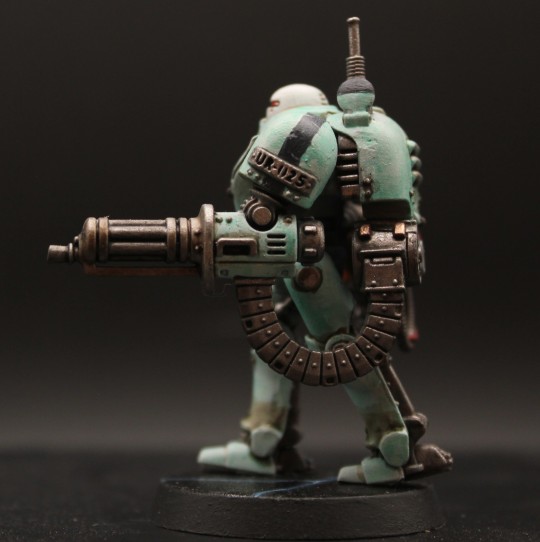
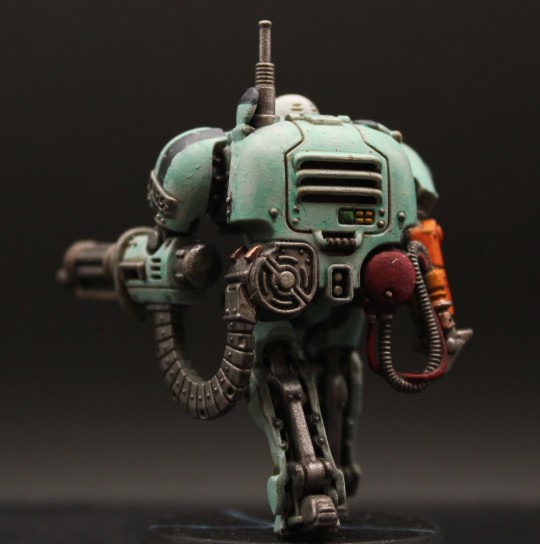
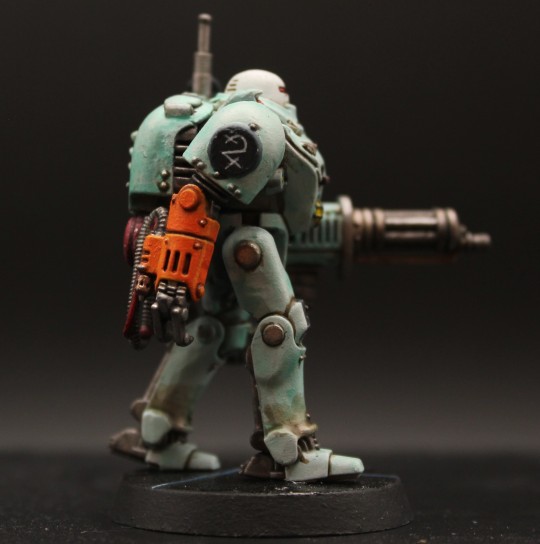
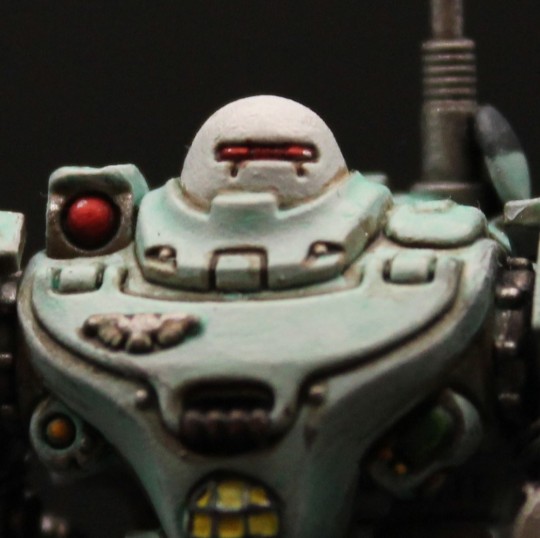
UR-025
"I am not a machine as you would understand. I am not a slave. I am not a thing. I am beyond and above you. I am a Man of Iron. And I am free."
this mini was absolute murder. My sympathies to any dedicated White Scars painters, shade and tint on top of white is deeply unforgiving. Very happy with the off-white green tone I got on their chassis. This marks the completion of all the player character minis for Blackstone. Stay posted for those delicious Traitor Guard.
157 notes
·
View notes
Text
Saturday 2nd April 1947
Made a trip to Little Marrow. Asked around for more information about shipwrecks. It turns out that the belt buckle I found belonged to a man who died at sea, and I was able to return it to his grieving father.
The Dockworker told me a strange tale. Apparently, some twenty years ago, a fisherman hauled up an old sealed casket from the seafloor, and took whatever was inside for their own. That night, the fog rolled in for the first time, and it has appeared every night since. Nobody knows what was in the casket, as all the crew who saw it went mad.
The timing of this seems to coincide with the purchase of Blackstone Isle and the diary entries I have been finding, though it is unclear if there is any correlation, or which events followed which.
Sold the trinkets I dredged up to the Trader. Met a Painter whom I did not see last time I visited - perhaps I will get the Angler repainted at some point. He has asked me to bring him colourful crabs as sources of pigment - I shall have to keep an eye on my pots.
3 notes
·
View notes
Text
Birthdays 6.30
Beer Birthdays
Louis J. Hauck (1866)
Larry Berlin (1961)
Nick Funnell
Hildegard Van Ostaden (1975)
Five Favorite Birthdays
Bo Carter; blues musician (1892)
Stanley Clarke; jazz bassist (1951)
Susan Hayward; actor (1917)
Lena Horne; singer, actor (1917)
Brendan Perry; rock musician (1959)
Famous Birthdays
Florence Ballard; pop/soul singer (1943)
Robert Ballard; oceanographer (1942)
Fantasia Barrino; singer-songwriter and actress (1984)
Thomas Lovell Beddoes; English poet (1803)
Madge Bellamy; actress (1899)
Paul Berg; biologist (1926)
Harry Blackstone Jr.; magician (1934)
Brian Bloom; actor (1970)
Lizzy Caplan; actress (1982)
Murray Cook; singer, "Wiggles" (1960)
Man Mountain Dean; wrestler (1891)
Vincent D'Onofrio; actor (1959)
Georges Duhamel; French author (1884)
Nancy Dussault; actress and singer (1936)
John Gay; English writer (1685)
Alicia Fox; wrestler, model, and actress (1986)
Archibald Frazer-Nash; English car designer (1889)
David Garrison; actor (1952)
James Goldman; screenwriter and playwright (1927)
Winston Graham; English author (1908)
Rupert Graves; actor (1963)
David Alan Grier; actor (1955)
Larry Henley; singer-songwriter (1937)
Barry Hines; English author (1939)
Joseph Dalton Hooker; English botanist and explorer (1817)
Allan Houser; sculptor and painter (1914)
Mario Lanfranchi; Italian film director (1927)
Hal Lindes; American-English guitarist (1953)
Czesław Miłosz; Lithuanian writer (1911)
Kelsi Monroe; adult actress (1992)
Raymond Moody; parapsychologist (1944)
Tony Musante; actor (1936)
Clive Nolan; English musician (1961)
José Emilio Pacheco; Mexican poet (1939)
Brendan Perry; English singer-songwriter and guitarist (1959)
Michael Phelps; swimmer (1985)
Monica Potter; actor (1971)
Julianne Regan; English singer-songwriter and guitarist (1962)
Andy Scott; rock guitarist, singer (1949)
Harry Shields; jazz clarinetist (1899)
Glenn Shorrock; English-Australian singer-songwriter (1944)
Thomas Sowell; economist (1930)
Stanley Spencer; English artist (1891)
Mark Spoelstra; singer-songwriter and guitarist (1940)
Ron Swoboda; New York Mets OF (1944)
Eleanor Ross Taylor; poet (1920)
Mike Tyson; boxer (1966)
Dave Van Ronk; singer-songwriter and guitarist (1936)
Horace Vernet; French painter (1789)
Friedrich Theodor Vischer; German author, poet (1807)
Brian Vollmer; Canadian singer (1955)
Rich Vos; comedian (1957)
Heinz Warneke; German-American sculptor (1895)
Mark Waters; film director (1964)
Philip Adrian Wright; rock keyboardist (1956)
Ed Yost; hot-air balloon inventor (1919)
2 notes
·
View notes
Photo

Living Room Loft-Style in Nashville
#Inspiration for a large modern loft-style carpeted living room remodel with white walls white walls#blackstone painters#nashville painters#stained wood wall boards#stained wood wall#stained beams
0 notes
Photo

Harriet Blackstone (American, 1864 - 1939): Indian Boy (Joe Archelita) (1918) (via Smithsonian)
#Harriet Blackstone#american painters#women artists#women painters#art#painting#portrait#kids#1910s#twentieth century
116 notes
·
View notes
Audio
Nightingale Vocal Ensemble - Composition Sped Up - improvised music highlighting the range and fluidity of the human voice
“Improvisation is just composition sped up." —Wayne Shorter
Full liner notes with photos: www.nightingalevocalensemble.com/composition-sped-up.html
Since its formation in 2019, Nightingale Vocal Ensemble has comprised singers who are also composers. Those singer-composers have written dozens of original works for the ensemble, and those works have received première performances in live concert events and sophisticated video productions. Composition is an essential facet of Nightingale’s identity, and it felt natural to attempt it—in Shorter’s words—Sped Up. Given the novelty of a cappella free improvisation, this project needed special musicians comfortable with total liberty and capable of making audacious musical choices. Fortunately, a group of my favorite virtuoso singers were eager to dive into this new world with me. While laying the groundwork for this album, the idea arose to improvise based on existing prompt material. I reached out to a variety of artists (painters, illustrators, poets, rock balancers, and more) about the possibility of us drawing musical inspiration from their work. I felt slightly apprehensive about making this inquiry, but I'm very glad I did it, because the response was profusely positive. Beautiful pieces were shared with us, and new friends are now a part of our Nightingale artistic community. On November 4th, 2022—following a series of rehearsals in which we established a rapport among our ensemble—we traveled to Big Nice Studio in Rhode Island, nestled among resplendent foliage beside the Blackstone River. We arranged ourselves in a semicircle under the studio’s 32-foot ceiling, and followed the same procedure for every recorded take. First, we collectively negotiated which of the prompts we were in the mood to interpret. After agreeing on one, each singer summoned the appropriate image or poem on a personal device. We briefly discussed whether to impose a musical rule or restriction for the impending improvisation. Finally we stood in silence, absorbing the prompt and awaiting inspiration. Each time, music soon materialized.... In most vocal ensembles, singers are typically assigned a particular part (e.g. soprano, alto, tenor, bass, etc.). We made no such attempt to classify ourselves. On this album, every person performs every possible musical role. Due to the flexibility of role and range that every singer embraced, I find it difficult to tell who is singing what at any given moment. This is truly equal music-making. The human voice—devoid of keys, frets, strings, or any discrete component—produces a pitch continuum, and it is unmoored to any tuning system. In the a cappella domain that we chose to inhabit, pitch is a liquid thing, and can itself be an expressive device. On this album, we flow freely throughout the tonal landscape, and juxtapose musical ideas in conventionally impossible ways. We didn’t set out to create microtonal music, but the fluidity of pitch uniquely enabled our musical and emotional expression. This album represents the best of our work that day. Every track was performed live, in a single take, with no overdubbing. Some of the takes have been trimmed down, but nothing has been rearranged or transformed. This is not musique concrète. This is live, acoustic performance. Every singer in the ensemble was utterly essential to the creation of this album, contributing an abundance of both musical expertise and—maybe more importantly—individual personality. Emma Newton's thoughtful and incredibly detailed mix brought out the best of each voice's contribution. Big Nice Studio was an inspring place to create. This album is just the first step into a musical frontier, and it represents one possible path ahead for new vocal ensemble music. We hope to share further exploration soon. —Nathan Halbur credits Vocals: Nicholas Ford, Nathan Halbur, Rose Hegele, Barbara Allen Hill, Lysander Jaffe, Benjamin Perry, Juan Suarez, Angela Yam
#Nightingale Vocal Ensemble#nathan halbur#choral#choir#improvised music#avant-garde#2023#modern classical#vocal ensemble
3 notes
·
View notes
Photo
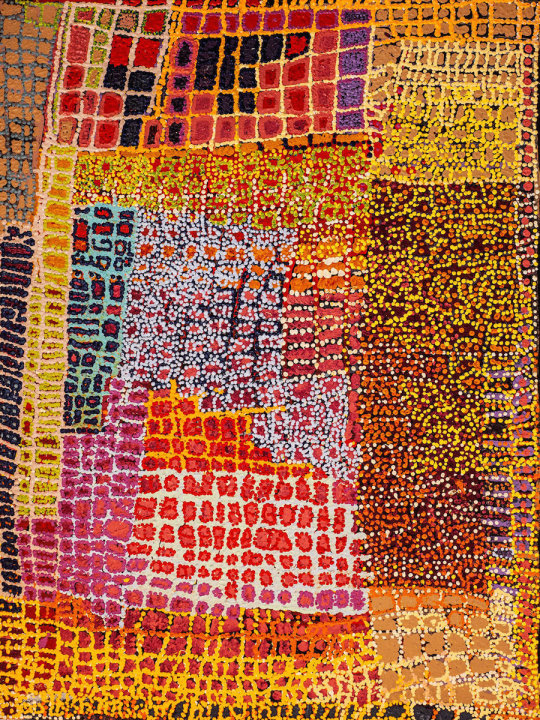
The late Tommy Mitchell, 1943-2013, Warakurna Artists.
Tommy Mitchell was born near Blackstone in WA and lived in Warakurna where he was a senior lawman and major painter in his 70s at the end of his life. His country was Nganturn and Walu.In his canvas paintings, Tommy Mitchell had the ability to evoke a sense of the elemental forces of nature that complimented the physical and ancestral aspects of the landscape. He was raised in the traditional manner living off the land with his family in the harsh environs of the Gibson Desert.
He grew to be a ceremonial leader among the Ngaanyatjarra people. Apart from painting, Tommy Mitchell was also renowned for carving ceremonial weapons.
https://www.cooeeart.com.au/.../artworks/available/mp_564/
32 notes
·
View notes
Text
So here are a bunch of headcanons about some of the gods from On the Shoulders of Giants who haven’t had quite as much time in the spotlight yet!
The Mother of Invention is named Eureka. When an inventor makes a breakthrough, they yell out her name to thank her for the inspiration she has given them.
The Trifecta Within (The Mother of Invention, The Iridescent Opal, and the Obsidian Author) all created Holy Arms that take the form of the tools of their craft.
The Mother of Invention created a pure mother-of-pearl wrench that can change size to fit any bolt. The wrench can also grow large enough to be used as a club.
The Obsidian Author's personal writing implement is a black-feathered quill. On close inspection, the feather is revealed to be made of obsidian. Its extremely sharp edge allows it to double as a knife. Although the Holy Arms are meant to be wielded by a mortal servant of a god, Mr. Blackstone himself is currently the de facto head librarian of the Obsidian Athenaeum, meaning he is entitled to the quill. Some say he keeps the position just because he really likes that quill.
The Iridescent Opal's divine implement is the Prismatic Palette: a flat disc of rainbow opal, shimmering in every color imaginable. When its paired paintbrush is touched to its surface, the tip of the brush takes on the color that it touched. The palette and brush can expand to become an aspis shield and a spear. The indentation on the palette becomes the spear-hole of the shield. In combat, the wielder of the shield can make it shine and dance in a dizzying array of colors, blinding their enemies.
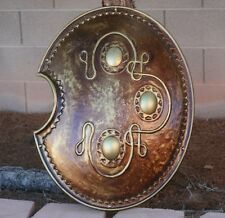

[ID: Two images. The first is an antique Greek aspis shield. It is nearly circular, but has a small circular section cut out of the edge, like someone has bitten it. The second image is clipart of a circular painter's palette, showing a similar cutout in its edge.]
To return to the Obsidian Athenaeum for a moment: Absolute silence is required inside the library at all times. In order to communicate with each other, the librarians use enchanted quills that write on two surfaces at once: the paper they hold, and the paper of the recipient. There are two reasons this is used instead of sign language: first, it means that all conversations are recorded, which fits the goals of the library. Second, it means that Mr. Blackstone, with his ability to read any text, anywhere, always knows what's going on in his library.
Finally, The Lady Justice Herself. Her Holy Arm is the Justice's Triad: A weapon made of pure crystalline ice, with three forms. In any form, the weapon allows its chosen wielder, the Chief Justice, to sense wickedness and lies in the hearts of others. When this ability is mastered, the wielder can sense the ill intent of others so precisely that they do not need their vision to face an enemy. This is just as well, as lack of sight is a prerequisite for being the Chief Justice.
The weapon switches between its three forms by melting and re-freezing. Each form represents a different stage of criminal processing. The three forms are the Just Restraints, the Sword of Truth, and the Permafrost Axe.
The Just Restrains are used for capture. They are two scales of justice, connected by a long chain, like boleadoras. They cover the limbs of any enemy they touch with ice, hindering their movement. They can also be thrown.

[ID: Two tennis ball-sized metal orbs, connected by a long chain]
The Sword of Truth is a sword of medium length, recognizable as the blade wielded by the Lady Justice Herself. It is used in criminal trials, as it has the ability to compel the truth from anyone it is pointed at. The sword isn't just for show, either; it is sharp as any blade.
The Permafrost Axe is an executioner's tool, a large two-headed axe used only for the vilest of criminals. It is engraved with the scales of justice; one scale on each blade of the axe, with the handle acting as the the pole that supports the scales. The axe's cold edge does not cut skin or rend flesh; when it would strike a fatal blow, the axe transforms its target into a statue of solid ice that will never melt. These statues are put on display in the hallway leading to the execution chamber. These statues are only ever seen by those on the death row; they are put in place by servants of the Lady Justice who wear blindfolds, and the Chief Justice is blind. As a result, anyone who lays eyes on these statues knows that they will soon join their frozen ranks.
The Justice's Triad can only be wielded by those who are pure of heart. If an unworthy individual tries to hold it, the weapon will immediately melt into water. If someone worthy of wielding the weapon reaches towards the water, it will re-freeze and can be picked up.
As a footnote, all the deities mentioned here do canonically exist in the world of Roll Dice and Cry, but most of them aren't mentioned a lot.
#rdacast#roll dice and cry#on the shoulders of giants#headcanons#actual play podcast#dungeon world#i just like these aesthetic crystal weapons
8 notes
·
View notes
Photo

Oliver Dennett Grover - Self portrait -
Oliver Dennett Grover (1861 Earlville, Illinois – 1927 Chicago), was an American landscape and mural painter, the son of lawyer Alonzo Jackson Grover.
Grover's family moved to Chicago early in his life. There he spent much of his time sketching at the Academy of Design. Showing great promise he was enrolled at Munich’s Royal Academy in 1879, where he studied under Frank Duveneck. At the age of 19 he exhibited at Munich’s International Exposition. Grover followed Duveneck to Venice and Florence, and then went on to study in Paris from 1883 to 1885 under Gustave Boulanger, Jean-Paul Laurens and Lefebvre.
He returned to Chicago in 1885 and was appointed as an instructor at the Art Institute of Chicago for five years, also opening a studio and founding the Western Art Association. Between 1887 and 1892 he served on the faculty of the Chicago Art Academy. Ada Walter Shulz was among his pupils.
The First Yerkes Prize was awarded to Grover in 1892 for his painting "Thy Will Be Done" showing a woman devastated by news she had just received, and which was exhibited at the World’s Columbian Exposition. Grover's reputation as a traditional painter and art authority was by this time firmly established in Chicago. He painted the "Harem Scene" in 1899, his contribution to the Orientalist genre. He exhibited three Venetian sketches at the St. Louis Universal Exposition, also showing at the Pennsylvania Academy and the National Academy of Design. He painted murals for the James Blackstone Memorial Library in the mid 1890s and for the Blackstone Memorial Library in Chicago in 1903, his lunettes there representing Art, Literature, Science and Labor. His "Ponte Vecchio", "Florence" and "Rocky Shore: Lake Garda" were displayed at the Panama-Pacific International Exposition.
Grover became an Associate of the National Academy of Design in 1913. During the last years of his life, he also became a board member of the Association of Arts and Industries which was a major influence in Chicago design in the 1920s and 1930s. Grover concentrated on portraits, landscapes and decorative designs, often making trips to Europe. Travelling to the Pacific Northwest he produced a number of landscape paintings of Banff.
9 notes
·
View notes
Text
Imperfection and Immolation
There exists a town on the far off shore of Israthel and in that town lies a very, very wealthy family, one that had the most beautiful children. And it is this family, the Blackstone Monarchy, that took the island of Israthel from the shining beacon of heavenly fire to the smoldering ruins it is now. From their perfection sprang a terrible flame that would refuse to be snuffed out.
You see, the island of Israthel was home to the high arts. It was an island brimming with artisans and craftsman of all sorts. It was home to many art galleries, studios, theaters, and had vineyards that stretched on for miles and miles.
It was a lynchpin of trade and layed between some of the largest and most powerful kingdoms. Everyone clambered for a place to dock and trade, somewhere to wait out the great storms of the sea, relax, and enjoy the splendors of civilized life while out on the ocean.
Israthel was a wondrous place. It had food and customs that stretched across kingdoms and held many famous festivals. The most notable festival was the festival of fire, the Lantern Festival. The many great artists and craftsman would come together and send their wishes up into the air, taking their passion and love and letting it light up the sky. It was a festival of joy, one of love and prosperity, and it was held by the wealthiest family on the island.
The family that held the festival was the Blackstones. They were merchants and the wealthiest patrons on the island. They believed, foolishly, that they were perfect.
They had a beautiful, expansive estate.
They had many works of art, ranging from paintings to sculptures.
And they had beautiful, talented children.
The children of the Blackstone family possed a number of desirable traits. They were healthy, brilliant, quick witted, and skilled in the arts.
The youngest daughter was skilled in the art of apiculture, the keeping of bees. The bees were vibrant and full of life. They had received only the best care and the youngest daughter would ensure that herself. After all, the Blackstone bees were instrumental in the maintenance of their vast gardens, which was the grandest feature to the estate.
The gardens were, to put it how so many had phrased it, perfect.
There were beautiful trimmed hedges, a wide open courtyard, and a sickly rainbow tapestry of pale, muted flowers, like their lifeforce was frozen before they could reach their full radiance.
Every inch was sculpted to perfection and not a single blade of grass was out of place.
For being a garden, a place to celebrate the beauty of nature, it was a deathly, artificial place. It was cold, empty, and hollow.
The gardens had no soul. And the youngest daughter hated it.
How could her poor bees, these beautiful perfect creatures, have their worked sulled by the grim upkeep of the gardens? Their life giving work, their work that can produce the most splendid of things, was being squandered to maintain the unnatural, irreverent, and disgusting gardens.
The perfect daughter hated the perfect landscape, so clearly one of those things was not as perfect as the Blackstones had thought. They decided that it was their daughter who was imperfect, a crass assertion that would not be entirely without merit. She was imperfect, but so are all living things.
The youngest daughter held within her a flame, a sort of passion that grew well past the outline she was supposed to live within. She had a passion about her, a spark of life that lived within her, one that was vastly dissimilar from her family and was very much like all the artisans and craftsman of the island.
And yet, rather than nurture her spirit, her family demanded her to change.
They took her from her bees and forbade her from ever stepping foot near the gardens, lest she tear it apart like the devil child she is.
They trapped her in every possible sense.
When she spoke out they scolded her.
When she pleaded to seek the arts they denied her.
When she snuck out to be with her bees they punished her.
She was stifled, choking, and longing to be free.
And then the Lantern Festival began. The day where the great artists of the island take their passion and set it free. The most beautiful, joyous, happy, splendid festival that made the twisted, unnatural gardens breathe a breath of life.
It was on that day that everything went to hell.
The Lantern Festival was held in the gardens, the place where the imperfect daughter was forbidden to enter.
But forbiddance could never stop the spark of life that dwelled within artists.
A painter needs their canvas.
A sculpture needs their clay.
And the imperfect daughter needed her bees.
And there was no better time to acquire those things than when everyone was up in arms and having a good time. So the imperfect daughter planned to sneak out to be with her bees once more.
When sunset came and it was time to release the lanterns up into the air and the festival would be in full swing. She would steal a lantern and take it to the hive, hiding her bees inside. By opening and closing the seal on the top she could safely and stealthily move them and so she could set them free, all without a single soul knowing.
She snuck her way to her bees and carefully lead them into her lantern. She could only fit a few without anyone noticing, but it was enough to know some could be free. As she finished and began to sneak away to the town, she was stopped by her family. Deciding that, clearly, she just wanted to participate in the festival, they excused her actions. Much to her dismay this meant going to the gardens, the last place she wanted to be.
As they marched her to the gardens she protested, struggling to get away. This did not please her father, who thought she was finally making a turn around. It was only made worse when he forced her to participate in the lightning of the lanterns.
The imperfect daughter fought and tried to resist, but adults can easily over power a child, especially when they do not care for their emotions.
Her father ripped the lantern from her hands and her mother kept her at bay.
“Now dear, we are going to have a fun time. You don’t want to ruin the festival, do you?” her mother cooed as her father struck a match.
“It’s time you participated in the festival! Whether you like it or not, you can’t hate these gardens forever” her father said, gesturing to the dreadful gardens that his daughter could certainly hate forever.
The father held the match to the seal, setting it ablaze.
As the lantern rose up through the air there was a great whirring sound, a noise that echoed through the vast estate.
The daughter looked up in terror as she saw the only thing she truly loved go up in smoke. Her heart stopped.
The lantern floated up as her bees, now on fire, rained down over and around her, but never once harming her. They glowed like embers, brilliantly red and orange and yellow as they swirled around her, dancing across her body and surrounding her in beautiful, gleaming light.
And then something peculiar happened. Something more horrific than watching the only things you love burn before your eyes and something more surprising than discovering they were miraculously ok. The bees, rather than swarm and fly about wildly as one might expect, began to attack the garden, igniting it almost instantaneously. The bees seemed to multiply, flooding through the vast gardens with ease, burning the dreadful bushes and wretched flowers alike.
The Blackstones had tried to smother the ember inside their daughter and in doing so awakened an inferno.
The imperfect daughter was no longer afraid of her father or was forced to be ashamed of who she was. The world was burning down and she no longer felt afraid of anything. Everything she hated, along with all that she loved, was burning around her.
And she loved it. Oh, she loved it.
She could feel all of it. She sensed the flames just as she had for her bees. They were one and the same. It was kind, playful, and inviting to the young girl. And much worse than that, it was obedient.
She held an outstretched hand towards her mother and father. The embers glistening in the black smoke swarmed towards her command, like a thousand blazing darts. The swarm washed over them like a wave of pure fire, lapping against the cliffs. They were utterly consumed, engulfed in the heat and chaos.
And the destruction did not stop there.
The swarm would continue to raze every single inch of the island until there was nothing left, only ashes and soot and dust.
The island burned.
And it was no more.
No towns, no gardens
No artists, no festivals
The desolate, charred landscape only features were mounds of ash.
But within those ashes lied an ember, a faint, glistening spark in the gloom.
The ember grew and grew, sputtering intensely as it struggled to keep itself alive.
From the ashes, something was born. Something dreadful rose up. A single hand reached up from the weak flame, pulling out of it a body as intense and as scorching as the sun. It’s hair was long and flowing, bellowing with smoke and it’s skin was red hot metal.
Arlana, the goddess of fire, was born, forged from the ashes of her former life.
As she surveyed her landscape and her new life, she felt a familiar presence. Lingering embers began to rise from the ashes as small bees, covered in soot, flew up to greet her.
Her old life was gone, nothing more than bad memories and cinders.
As she looked out over the wastes a single desire burned in her mind, searing itself into her heart, and igniting her very soul.
She would purge the world of its perfections, of its lies too good to be true.
She would burn as bright as the setting sun and engulf the world in flame.
Such is fate
And such is her will.
9 notes
·
View notes
Text

Esther Morgan McCullough (19 March 1888 – June 14, 1957) was an American novelist and anthologist.
Her unpublished biography of painter Harriet Blackstone is among the Harriet Blackstone Papers in the Smithsonian Institution.
Her longtime companion was the pianist Stell Andersen.
Cora Stell Andersen (1897–1989), also known as Cora Andersen, was an international concert pianist who toured during the 1920s with Silvio Scionti performing piano duos. In the 1930s and 1940s, she toured as a solo pianist and was the only American soloist invited to perform at the 1937 Paris Exposition. Via Wikipedia
0 notes
Text
KNOW ALL ABOUT MADHUBANI PAINTING

Madhubani painting is an ancient art form which has gained a lot of popularity in recent times. The art form originated in the Indian state of Bihar and was popularised by Lalit Kumar Saxena, who was born in 1951. It is one of the most prominent forms of Indian art that have been practised for centuries. The earliest examples have been dated back to 1500 BC and even before this time, there are references to figures being painted on pottery vessels as well as wooden tablets known as ‘Vedic tablets’ or ‘Blackstone Tablets’ which were used by priests during religious rites.
History of Madhubani painting:
Madhubani painting is an ancient art form that originated in Mandal, Bihar. The origin of madhubani paintings can be traced back to 12th century AD, when it was used for religious purposes at the Jain temples.
Madhubani paintings are popular in Bihar and Jharkhand because of its unique style, which includes intricate details on rice paper or cloth using pastel colors like white and blue-green; gold dust or silver powder used as pigments; flowers made from flower petals such as lotus leaves (white) or tulips (red), etc.
Madhubani paintings are often used as a form of adornment for the walls of houses, temples or even as bed sheets. Some artisans also use them to create greeting cards and other products.
What is this art form?
Madhubani painting, a folk art practiced by women in the Mithila region of Bihar state in India, is an excellent example of an ancient tradition that has gone on to flourish over time. It is a traditional form of art that originated as part of religious rituals and has since evolved into an important form of expression for many people across the country. The practice continues today with some artists still using old techniques and materials while others continue to experiment with new ideas.
Mithila painting is an important part of the region’s culture and identity, with many artists using it to explore social issues and express their opinions. It has also been used as a medium for expressing political views; in 2016, a group of women painters created a mural on one of the walls at the government secretariat in Bihar state to protest against sexual harassment.
Types of Madhubani paintings:
Madhubani paintings can be divided into two broad categories - Madhubani paintings of the plains and Madhubani paintings of the hills. The Madhubani paintings of the plains are usually made on paper or cloth, while those of the hills are made on walls.
The first type includes all kinds of geometric designs done with a stick in different colours and shapes like triangles, squares etc., but does not include any figures or designs that represent people or animals as these are not suited for such purpose due to their small size (approximately 1-2 cm). A typical example would be an eight-pointed star which has eight equal points but no central point like an asterisk would have been in earlier times when these were used as decorations in homes where there were no windows available so people had no means to look out through them at night time when they heard noises being made outside by wild animals trying unsuccessfully to get inside; thus, making this form very effective at keeping unwanted intruders out!
The second type of Madhubani painting is usually done on the walls of houses in the hills, and although it does include some human figures, these are usually stylized to represent just about anybody who may be present at any given time. For example, a person walking down a mountain path would have been depicted as such by using lines that resembled that particular activity; thus, making it easy for people to recognize what was happening without having to use words which were not available back then anyway!
Madhubani paintings are an ancient art form which have gained a lot of popularity in recent times.
Madhubani paintings are an ancient art form which have gained a lot of popularity in recent times. It is believed that this art form originated from the Madhubani district of Bihar. This art form is popular across the world and has been adopted by various artists, including those who practice it in their own home away from home.
Madhubani painting is said to be very complex, as it involves many different techniques such as stippling, dotting, color mixing and so on. The colors used for these paintings are derived from natural sources like lemon grass powder (called khus), turmeric powder (called khur), saffron (called safeda).
Conclusion
Madhubani painting is an art form which has gained a lot of popularity in recent times. It has also been called the “Sanskrit of India” since its origins can be traced back to ancient times when it was mainly used for religious purposes. This article provides a detailed description of this art form with an emphasis on its history, origin and significance.
Penkraft conducts classes, courses, online courses, workshops, teachers' training & online teachers' training in Handwriting Improvement, Calligraphy, Abacus Maths, Vedic Maths, Phonics and various Craft & Artforms - Madhubani, Mandala, Warli, Gond, Lippan Art, Kalighat, Kalamkari, Pichwai, Cheriyal, Kerala Mural, Pattachitra, Tanjore Painting, One Stroke Painting, Decoupage, Image Transfer, Resin Art, Fluid Art, Alcohol Ink Art, Pop Art, Knife Painting, Scandinavian Art, Water Colors, Coffee Painting, Pencil Shading, Resin Art Advanced etc. at pan-India locations. With our mission to inspire, educate, empower & uplift people through our endeavours, we have trained & operationally supported (and continue to support) 1500+ home-makers to become Penkraft Certified Teachers? in various disciplines.
0 notes